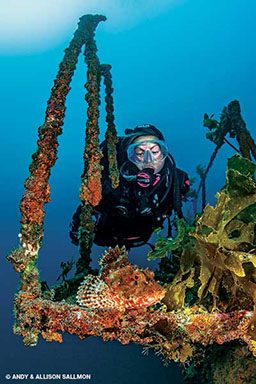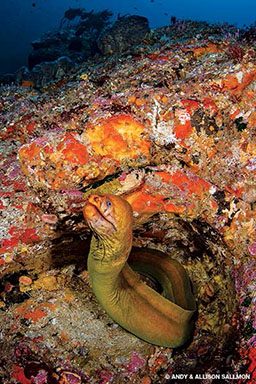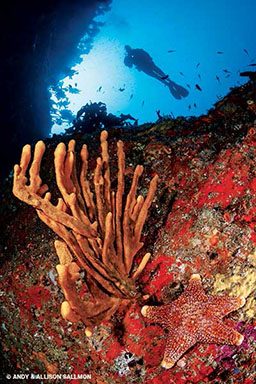A nearly unmanageable increase in dinner invitations: This is the first thing we notice when we tell people we are planning a dive trip to New Zealand’s Northland region. Email? Phone call? Facebook message? Forget it. Everyone who’s been there wants to tell us stories in person. Our increased popularity is great, I guess, because it enables us to notice something else — let’s call it The Look. Whether we’re scribbling down driving tips (“road maps of New Zealand are deceptive; just go ahead and double all your driving time estimates”) or pronunciation guidelines (“wh is actually pronounced f, so expect some interesting conversational snafus”), we look up only to see the same facial expression over and again: sentimental, love-struck awe — or The Look.
Random tips and guidebook lore aside, we have no real idea of what to expect from New Zealand, but there is something about The Look that gives us tunnel vision. Work, household events and (I’m ashamed to say) local dives blur into the background as our journey approaches. By the time we land in Auckland, our anticipation has reached fever pitch.
Bay of Islands and Beyond
We’re late for our first charter in New Zealand, and it’s not because we’ve slept in. Similar to 8 a.m. commuters the world over, we’re stuck in traffic. I hit the horn impatiently, and the noise echoes off terraced, hilly pastures. The source of our delay looks up and utters an indignant moo before lumbering off the road, and our nervous titters about being tardy give way to snorts of laughter. The Bay of Islands’ reputation — touristy and laden with backpackers — is tough to reconcile with the deserted 1.5-lane roads, escaped livestock and optimistic fueling-station signs (“Gas: Only 17 km!”) that surround us.
When we reach our destination, however, it’s bustling. The dive operation, a converted cowshed next to a meandering, eel-filled stream, is crowded with a boisterous group of students from the University of Auckland. We’re met with warm greetings and enthusiastic descriptions of the dive site, the HMNZS Canterbury, a purpose-sunk frigate. While we don our drysuits, a teen sporting an insanely thin freediving wetsuit saunters over to provide his opinion of the wreck, using a classic Kiwi superlative: “This is my favorite dive in the bay. It’s sweet as!” This is equivalent to an American “awesome,” so our expectations are justifiably high.

True to its reputation, the site is indeed “sweet as.” Resting on its keel in 120 feet of water, the Canterbury has attracted incredible fish life. Large scorpionfish lie on sponge- and anemone-encrusted decks and railings, spiny lobsters tuck into speakers, moray eels gape out from the wheelhouse, and a John Dory stares at us from within a vent. On ascent, we inadvertently find ourselves in the middle of a silvery school of sweeps, which are being corralled by a pair of ravenous kingfish.
During our surface interval, the captain regales us with stories of the marine life spotted by local divers during safety stops in this cove, including bottlenose and common dolphins, blue penguins and — gasp! — a pod of orcas that dropped by to play with the anchor chain just a few weeks ago. We immediately decide to lengthen our safety stops.
The next morning is clear and calm, providing us a chance to head for the Cavalli Islands to dive the Rainbow Warrior. The ship, a Greenpeace vessel that was protesting nuclear testing in the Pacific, was bombed by French intelligence operatives in 1985 while at harbor in Auckland, killing one man and sparking a political scandal. After being refloated for investigation, the ship was sunk in 1987 to create an artificial reef. The Cavallis lie more than 25 miles from our departure point, and during the long ride over, the mood on the boat is quiet; the dive site might be renowned, but it’s clear that memories of the tragedy remain.

As soon as we begin our descent, we can see the wreck 90 feet below us. We head straight for the ship’s iconic bowsprit, marveling at the brightly hued jeweled anemones that cover the latticed structure and working to photograph the majestic scene. We’re both shooting wide angle today, using camera lenses that capture 180-degree views, which unintentionally leads to a photographer’s nightmare. I glance at an Ecklonia kelp plant on the deck and spy a 3-inch-long crested weedfish — one of the most sought-after critters in the area. These cryptic beasts look just like kelp, and they are bashful as well. Visiting photographers rarely get a chance to see one, much less photograph it. I groan disgustedly into my regulator, cursing my lens choice. I attempt to get a good, long mental image instead, but as soon as the creature sees me, it darts behind a leaf. I satisfy myself that I would not have had much of a photo opportunity in any case, and I move on, exploring the deck and taking note of moray eels, darting leatherbacks and hunting kingfish.
In the days that follow, we revisit the Canterbury, but we also branch out from wrecks to reefs, which are commonly associated with stunning topside features. Motu Kokako, an oft-visited arch better known as Hole in the Rock (“Because it’s a bloody great hole in a rock,” our captain helpfully explains), marks the dive site Cathedral Cave. This sponge-lined fissure drops to more than 90 feet and can contain scores of short-tailed stingrays in the summertime. Even though the rays are a no-show during our autumn visit, there are plenty of gray moray eels and spiny lobster to keep us interested.
Just outside of the Bay of Islands lies another spot marked by distinctive surface topography. Danger Rock, a cluster of surge-swept, kelp-topped pinnacles and wash rocks, plummets from the surface to more than 120 feet deep. This exposed site is best known for large yellow finger sponges and even larger schools of fish, and it delivers. During our second dive here we find ourselves in a glittering, swirling mass of sweeps, and we take turns photographing their coordinated movements until our dive is over. Our enthusiastic report, however, seems practically humdrum compared with those of our fellow divers. I can almost hear their thoughts: “Sigh. Another day in wonderland, another safety stop, another colossal school of fish that obscures the sun.”
I suppose we’d better get used to all those fish because tomorrow we head south to one of the oldest marine reserves in New Zealand.
Poor Knights, Rich Knights

When our boat departs Tutukaka harbor for the Poor Knights Islands Marine Reserve, the mood onboard is upbeat. This cluster of uninhabited islands and pinnacles, a no-take zone since 1998, is legendary among divers. Unfortunately, after a week of sunshine and calm seas, the weather is no longer cooperating. We’re looking warily at the whitecaps surrounding the boat when the captain says, “I have bad news and good news. The bad news is that the swell and wind today are going to limit us to a single site. The good news is that the site rocks.”
We’re “restricted” to Northern Arch, a Poor Knights’ signature. Our briefing includes a stern caution: With a maximum depth of 120 feet inside the arch and 200 feet outside it, we must monitor our buoyancy carefully. We descend next to a steep wall covered with kelp, spindly yellow finger sponges and oddly shaped orange and gray sponges. As we turn the corner into the arch itself, however, the reason for the warning becomes clear. From top to bottom, it is crowded to capacity with a swirling school of pink maomao, New Zealand’s answer to the anthia. We shoehorn ourselves into the mob, and it takes serious discipline to watch our depth. Before we know it, we are back on the boat with two dives under our belts, stunned expressions on our faces and full memory cards, wondering what the heck happened.
The forecast predicts worsening conditions over the next few days. Our best bet, the captain says, is to moor in South Harbor, where we’ll have a few sites to choose from while we wait for the weather to settle down. We study the map on the boat: After yesterday’s extravaganza, any site named “arch” or “maomao” gets extra points, so there’s little question where we want to go first. Blue Maomao Arch is our pick, and again we hit the piscine jackpot. Streams of cobalt-blue fish swarm indifferently around us. This site may have a maximum depth of only 35 feet, but we quickly recognize that good buoyancy is every bit as important here as it was at Northern Arch when we see the huge scorpionfish sitting on the rocks.

When dark clouds begin to gather overhead, we decide that it’s a good time to go searching for small creatures. We grab the appropriate camera rigs and head to nearby Magic Wall, a jumble of sponges, bryozoans and gorgonians that drops from the surface to 70 feet and contains an abundance of photo subjects. We see various nudibranchs on the wall, though our favorite is the common Ceratosoma amoenum, a brightly colored beauty nicknamed the “sweet Ceratosoma.” A crevice reveals a pair of mosaic morays sharing space with a yellow moray. Triplefin species of all imaginable patterns and colors are common in Poor Knights, and they seem to congregate densely at this site. As we’re swimming back to the boat, I spot a flash of movement on the top of an Ecklonia kelp plant, and I stop in my tracks. I adjust my camera settings just in case, and I gently descend for a closer look… could it be?
I am certain that all of New Zealand can hear my whoop of delight when I climb back onto the boat, crowing victoriously: “Crested weedfish!”
The next morning the weather lets up, and we venture north to Barren Arch, a passage that drops to 100 feet. A more ridiculous misnomer does not exist; perhaps this is the reason the site bears the alternate name of Splendid Arch. The wide curve of rock shelters a massive school of demoiselles as well as a smaller cluster of blue maomao, and the adjacent kelp gardens hold large snapper, skittish stingrays and schools of mackerel. Nearby Cave Bay and Cream Gardens both consist of shallow kelp gardens that give way to thriving, steep walls that start at 75 feet. Between gorgonians, starfish and huge finger and vase sponges, speckled and moray eels swim beside the ubiquitous dog-sized scorpionfish. More short-tailed stingrays pass us at a distance, but they remain too far away to photograph. It isn’t until the next morning when we dive Middle Arch that we’re finally able to watch short-tailed stingrays soaring overhead within a shallow rock archway — a classic Poor Knight’s experience.

Our final dive arrives, and the captain decides that we can’t go home without viewing a shallow kelp garden called Gentle Forest. The site is sublime, and mackerels stream around us while large snapper challenge our dome ports in clear blue water. It’s our return to the boat, however, that delivers the most amazing spectacle of all: a thick shoal of demoiselles gathered under the hull. The fish nearly conceal the boat, allowing the occasional sunray to pierce through. The scene is somehow exempt from cliché, a fitting way to end our trip. I board the boat smiling, ready to pack for home.
Two days later, we’re settling into our seats for the 12-hour flight when a fellow passenger greets us and jealously inquires about our trip. She has only transited in Auckland, you see, and she didn’t even have time to leave the airport. I begin talking, blurting out ever more enthusiastic descriptions until the woman certainly regrets asking me about my experience. When I finally bite my tongue and turn toward the window for one last view of the coast, I spot my blurred reflection in the glass. The Look stares knowingly back, clear as a calm Northland day.
Dive In: Northland, New Zealand
Getting there: Many international airlines fly into Auckland, from which it takes approximately five hours (driving time adjusted) to drive to the Bay of Islands or three and a half hours to Tutukaka, which is the departure point for charters to the Poor Knights Islands.

Seasons, water temperatures and exposure gear: Even though New Zealand’s seasons are opposite those in North America, the large coastal area means that topside temperatures are relatively stable year-round. Summer (December to March) brings water temperatures of up to 70°F accompanied by visibility of more than 30 feet. Winter (May to August) water temperatures can drop to 55°F, but visibility is often excellent, sometimes exceeding 100 feet. A 7mm wetsuit or drysuit is recommended.
Skill level and conditions: Both the Bay of Islands and Poor Knights Islands Marine Reserve offer an array of sites to fit any skill level. Surge and currents can be strong in some areas, and marine conditions can change rapidly, so it is best to enlist the help of local dive operators during your visit. The nearest recompression chamber is located in Auckland.
While recreational divers can explore all of the sites described here, many are also ideally suited for open- or closed-circuit technical diving. On our recent visit, our technical efforts were supported by both Northland Dive and Oceanblue Adventures, who provided oxygen, air and custom nitrox fills as well as bailout bottles.
Make Your Own Dive Site, Kiwi-Style: The Sinking of the HMNZS Canterbury

Shane Housham and Julia Riddle were headed home from a day of diving in the Bay of Islands when they passed Deep Water Cove, a protected inlet abutting a picturesque mountain. Shane turned to Julia and jokingly said, “I’m going to put a shipwreck there someday.”
That joke turned out to be prophetic. When decommissioned Royal Navy frigate HMNZS Canterbury came up for tender auction a few years later, the couple recalled their conversation and attempted to contact the New Zealand Navy about acquiring the ship to create a purpose-sunk wreck in their dream location. Numerous emails and phone calls went unanswered, however, and Shane finally sent a desperate email directly to New Zealand’s Minister of Defense. The next day he received a formal note from the navy: He was officially in the running to take on the Canterbury.
Celebration gave way to consternation as the gargantuan size of the task before them took shape. The couple, basically a pair of casual divers, first had to win the tender auction against several long-established businesses. After completing mountains of complicated paperwork, Shane and Julia were finally granted the right to buy the ship for $1, a bargain-basement price that was promptly dwarfed by transportation and preparation costs of $1.1 million.
Realizing they needed help, the pair joined forces with an area dive operator to form a charitable trust. Donations began to pour in from individual contributors, and several dive clubs pitched in to help clear the ship and create access points for penetration. The couple’s goal seemed within reach when they encountered a final, but substantial challenge.
The most significant problem turned out to be neither financial nor labor-related but rather about real estate. The picturesque mountain (Mount Rakaumangamanga) adjacent to Deep Water Cove represented one-third of a sacred navigational triangle used by ancient Polynesians to cross the ocean. Because local Maoris at first rejected the scuttling idea, the divers added them to the trust, inviting their input on all aspects of the project and ultimately transferring ownership of the frigate to the local tribes. The Maoris came to embrace the artificial reef plan and at last granted final permissions.
In November 2007 the HMNZS Canterbury was sunk to fanfare in front of a large audience, creating a world-class dive site in a quiet cove where a pair of divers had once laughed about a seemingly impossible goal.
© Alert Diver — Q3 Summer 2014